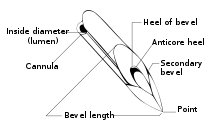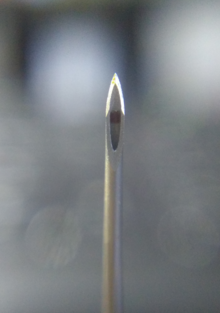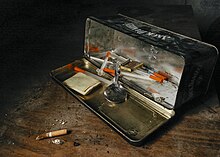what gauge needle is used to draw blood

Different bevels on hypodermic needles
![]()

Hypodermic needle features
A hypodermic needle (from Greek ὑπο- (hypo- = under), and δέρμα (derma = skin)), one of a category of medical tools which enter the skin, called sharps,[1] is a very thin, hollow tube with one abrupt tip. Information technology is commonly used with a syringe, a hand-operated device with a plunger, to inject substances into the body (e.g., saline solution, solutions containing diverse drugs or liquid medicines) or extract fluids from the torso (e.thou., claret). Big-diameter hypodermic intervention is especially useful in catastrophic blood loss or treating shock.
A hypodermic needle is used for rapid commitment of liquids, or when the injected substance cannot exist ingested, either because information technology would not be absorbed (as with insulin), or because it would harm the liver. It is also useful to deliver certain medications that cannot be delivered orally due to airsickness. There are many possible routes for an injection, with intramuscular (into a muscle) and intravenous (into a vein) beingness the nigh common. A hypodermic syringe has the ability to retain liquid and blood in it up to years after the terminal utilise and a great deal of caution should exist taken to use a new syringe every time.
The hypodermic needle also serves an important role in research environments where sterile conditions are required. The hypodermic needle significantly reduces contamination during inoculation of a sterile substrate. The hypodermic needle reduces contagion for two reasons: Beginning, its surface is extremely shine, which prevents airborne pathogens from becoming trapped betwixt irregularities on the needle's surface, which would later on exist transferred into the media (east.thou. agar) as contaminants; 2nd, the needle'due south surface is extremely sharp, which significantly reduces the bore of the hole remaining after puncturing the membrane and consequently prevents microbes larger than this pigsty from contaminating the substrate.[ii] [3] [4] [5]
History [edit]
Early employ and experimentation [edit]
The ancient Greeks and Romans knew injection equally a method of medicinal delivery from observations of snakebites and poisoned weapons.[6] In that location are likewise references to "anointing" and "inunction" in the Old Testament too as the works of Homer, but injection as a legitimate medical tool was not truly explored until the 17th century.[7]
Christopher Wren performed the earliest confirmed experiments with rough hypodermic needles, performing intravenous injection into dogs in 1656.[7] These experiments consisted of using animal bladders (equally the syringe) and goose quills (every bit the needle) to administrate drugs such as opium intravenously to dogs. Wren and others' principal interest was to acquire if medicines traditionally administered orally would be constructive intravenously. In the 1660s, J. D. Major of Kiel and J. S. Elsholtz of Berlin were the first to experiment with injections in humans.[6] [8] These early experiments were generally ineffective and in some cases fatal. Injection vicious out of favor for two centuries.
19th-century evolution [edit]

Syringe made entirely of glass, like to the Wood design, except it is etched with volume marks.
The 19th century saw the evolution of medicines that were constructive in small doses, such as opiates and strychnine. This spurred a renewed interest in direct, controlled application of medicine. "Some controversy surrounds the question of priority in hypodermic medication."[ix] Irish gaelic doc Francis Rynd is by and large credited with the first successful injection in 1844, in the Meath Hospital in Dublin, Republic of ireland.[10] [11]
Alexander Woods'south main contribution was the all-drinking glass syringe in 1851, which allowed the user to estimate dosage based on the levels of liquid observed through the glass.[12] Wood used hypodermic needles and syringes primarily for the awarding of localized, subcutaneous injection (localized anesthesia) and therefore was non as interested in precise dosages.[8]
Simultaneous to Wood's piece of work in Edinburgh, Charles Pravaz of Lyon as well experimented with sub-dermal injections in sheep using a syringe of his own design. Pravaz designed a hypodermic needle measuring 3 cm (i.18 in) long and five mm (0.2 in) in diameter; information technology was made entirely of silver.[13]
Charles Hunter, a London surgeon, is credited with the coining of the term "hypodermic" to describe subcutaneous injection in 1858. The name originates from two Greek words: hypo, "under", and derma, "skin". Furthermore, Hunter is credited with acknowledging the systemic effects of injection afterwards noticing that a patient's hurting was alleviated regardless of the injection's proximity to the pained area.[seven] [8] Hunter and Forest were involved in a lengthy dispute over not but the origin of the modern hypodermic needle, merely besides considering of their disagreement to the medicine's effect once administered.[14]
Modernistic improvements [edit]
Dr. Francis Rynd (1801–1861) used the first "Hollow Needle" equally a hypodermic syringe on Ms. Margaret Cox vi/3/1844 in Ireland. Dr. Wood tin can be largely credited with the popularization and acceptance of injection as a medical technique, equally well as the widespread use and credence of the hypodermic needle. The basic technology of the hypodermic needle has stayed largely unchanged since the 19th century, but as the years progressed and medical and chemical knowledge improved, modest refinements have been made to increase safety and efficacy, with needles being designed and tailored for very particular uses. Hypodermic needles remain essential to large book administration or exchange in settings of trauma or dialysis. The trend of needle specification for use began in the 1920s, particularly for the administration of insulin to diabetics.[15]
The onset of World War 2 spurred the early development of partially dispensable syringes for the administration of morphine and penicillin on the battleground. Evolution of the fully dispensable hypodermic needle was spurred on in the 1950s for several reasons. The Korean War created blood shortages and in response dispensable, sterile syringes were developed for collecting blood. The widespread immunization against polio during the menses required the development of a fully disposable syringe system.[15]
The 1950s also saw the ascension and recognition of cross-contagion from used needles. This led to the development of the kickoff fully dispensable plastic syringe past New Zealand pharmacist Colin Murdoch in 1956.[16] This period also marked a shift in interest from needle specifications to general sterility and safety.[15]
The 1980s saw the rise of the HIV epidemic and with it renewed concern over the rubber of cross-contamination from used needles. New safety controls were designed on dispensable needles to ensure the safety of medical workers in item. These controls were implemented on the needles themselves, such as retractable needles, only also in the handling of used needles, particularly in the use of hard-surface disposal receptacles establish in every medical function today.[xv]
By 2008, all-plastic needles were in product and in express apply. One version was made of Vectra (plastic) aromatic liquid crystal polymer tapered from 1.2 mm at the hub to 0.72 mm at the tip (equivalent to 22 gauge metal needle), with an ID/OD ratio of seventy%.[17]
Manufacture [edit]
Hypodermic needles are unremarkably made from a stainless-steel tube[eighteen] through a procedure known equally tube drawing where the tube is drawn through progressively smaller dies to brand the needle. The end of the needle is bevelled to create a sharp pointed tip, letting the needle hands penetrate the skin.[nineteen]

A hypodermic needle tip nether microscope
Gauge [edit]

Half dozen hypodermic needles on Luer connectors. These needles are commonly used with other medical devices, such every bit a syringe; from top to bottom:
- 26G × ane⁄ii ″ (0.45 × 12 mm) (chocolate-brown)
- 25G × 5⁄8 ″ (0.five × sixteen mm) (orangish)
- 22G × ane+ 1⁄four ″ (0.7 × 30 mm) (black)
- 21G × one+ 1⁄ii ″ (0.viii × 40 mm) (light-green)
- 20G × 1+ ane⁄2 ″ (0.9 × 40 mm) (yellow)
- 19G × one+ 1⁄2 ″ (one.i × 40 mm) (foam)
Run across also Birmingham estimate.
The main organization for measuring the diameter of a hypodermic needle is the Birmingham gauge (also known as the Stubs Iron Wire Gauge); the French gauge is used mainly for catheters. Various needle lengths are available for any given gauge. Needles in mutual medical apply range from seven estimate (the largest) to 33 (the smallest). 21-gauge needles are near usually used for cartoon blood for testing purposes, and 16- or 17-estimate needles are most ordinarily used for blood donation, as the resulting lower pressure is less harmful to cherry blood cells (it besides allows more claret to be collected in a shorter time).[xx]
Although reusable needles remain useful for some scientific applications, dispensable needles are far more common in medicine. Disposable needles are embedded in a plastic or aluminium hub that attaches to the syringe butt by means of a press-fit or twist-on plumbing fixtures. These are sometimes referred to equally "Luer Lock" connections, referring to the trademark Luer-Lok. The male and female person luer lock and hub—produced past pharmaceutical equipment manufacturers—are 2 of the most critical parts of disposable hypodermic needles.[21]
Use by not-specialists [edit]

Some Hypodermic needles used by recreational heroin users
Hypodermic needles are unremarkably used past medical professionals (dentists, phlebotomists, physicians, pharmacists, nurses, paramedics), but they are sometimes used past patients themselves. This is virtually mutual with blazon 1 diabetics, who may require several insulin injections a day.[22] It also occurs with patients who have asthma or other severe allergies. Such patients may need to take desensitization injections or they may need to carry injectable medicines to use for outset aid in case of a severe allergic reaction. In the latter case, such patients often carry a syringe loaded with epinephrine (e.thou. EpiPen),[23] diphenhydramine (e.g. Benadryl), or dexamethasone. Rapid injection of i of these drugs may stop a severe allergic reaction.
Multiple sclerosis patients may also treat themselves by injection; several MS therapies, including various interferon preparations, are designed to be self-administered by subcutaneous or intramuscular injection.[24] In some countries, erectile dysfunction patients may exist prescribed Alprostadil in injectable course, which is self-injected directly into the base or side of the penis with a very fine hypodermic needle.[ citation needed ]
Hypodermic needles are also used by untrained users in recreational intravenous drug use (e.one thousand., injecting solutions of heroin and water). Earlier governments attained current levels of awareness near the spread of disease through shared needles, hypodermic syringes in many countries were available only by prescription. Thus, in club to limit the spread of claret-borne diseases such as hepatitis and HIV through shared injection equipment, many countries take needle exchange programs in most larger cities. In some countries, such programs are wholly or partially subsidized past the regime.[ citation needed ]
Blunt needles, manufactured without a sharp bevel and commonly non-sterile, are used industrially for filling pocket-sized containers or accurately applying small amounts of solvent or glue.
Phobia [edit]
It is estimated that anywhere from near three.5 to 10% of the globe'southward population may have a phobia of needles (trypanophobia),[25] and it is much more than mutual in children, ages v–17. Topical anesthetics tin exist used to desensitize the area where the injection will have identify to reduce pain and discomfort.[26] For children various techniques may be constructive at reducing distress or pain related to needles.[27] Techniques include: lark, hypnosis, combined cerebral behavioral therapy, and breathing techniques.[27]
See as well [edit]
- Cannula
- Catheter
- Intravenous therapy
- Nanoneedle
- Needle and syringe programmes
- Needle biopsy
- Needle guess comparison chart
- Needle remover
- Needlestick injury
- Pin prick attack
- Supervised injection site
- Tuohy needle
References [edit]
- ^ "Handling sharps and needles: MedlinePlus Medical Encyclopedia". medlineplus.gov . Retrieved April 4, 2022.
- ^ Elsheikh, HA; Ali, BH; Homeida, AM; Lutfi, AA; Hapke, HJ (May–June 1992). "The effects of fascioliasis on the activities of some drug-metabolizing enzymes in desert sheep liver". The British Veterinary Periodical. 148 (3): 249–57. doi:x.1016/0007-1935(92)90048-6. PMID 1617399.
- ^ Korenman, SG (September 1975). "Estrogen receptor assay in man breast cancer". Journal of the National Cancer Institute. 55 (3): 543–v. doi:x.1093/jnci/55.3.543. PMID 169381.
- ^ Scott, Gene E.; Zummo, Natale (Jan i, 1988). "Sources of Resistance in Maize to Kernel Infection by Aspergillus flavus in the Field". Crop Science. 28 (three): 504. doi:10.2135/cropsci1988.0011183X002800030016x.
- ^ Leuchtmann, Adrian; Clay, Keith (1988). "Experimental Infection of Host Grasses and Sedges with Atkinsonella hypoxylon and Balansia cyperi (Balansiae, Clavicipitaceae)". Mycologia. fourscore (3): 291–297. doi:10.2307/3807624. JSTOR 3807624.
- ^ a b Norn S, Kruse PR, Kruse E (2006). "On the history of injection". Dan Medicinhist Arbog. 34: 104–1.
- ^ a b c Kotwal, Atul. "Innovation, diffusion and prophylactic of a medical technology: a review of the literature on injection practise". Social Science & Medicine Volume threescore, Event 5, March 2005, pp. 1133–1147
- ^ a b c Brawl C (June 2006). "The early development of intravenous appliance". Anaesthesia and Intensive Care. 34 (Suppl one): 22–six. doi:10.1177/0310057X0603401S02. PMID 16800224.
- ^ Logan Clendening, Source Book of Medical History, p. 419 (1960)
- ^ Walter Reginald Bett, The History and Conquest of Common Diseases p. 145 (1954)
- ^ "The Irish doctor who invented the syringe". irishtimes.com . Retrieved April 4, 2022.
- ^ Kotwal, Atul. "Innovation, improvidence and safety of a medical engineering: a review of the literature on injection practices". Social Scientific discipline & Medicine Volume 60, Issue five, March 2005, pp. 1133–1147
- ^ Syringe, Discoveriesinmedicine.com
- ^ Brunton, D. (2000). "A Question of Priority: Alexander Forest, Charles Hunter and the Hypodermic Method". Proceedings of the Royal College of Physicians of Edinburgh. 30: 349–351.
- ^ a b c d Beckton Dickinson and Company, "Four Major Phases of Injection Device Development", Syringe and Needle History
- ^ "Hypodermic syringe". world wide web.sciencemuseum.org.great britain . Retrieved April 4, 2022.
- ^ Busillo, Eric (July ix, 2008). Characterization of Plastic Hypodermic Needles (PDF) (Thesis). Georgia Plant of Technology.
- ^ How practise they get the pigsty through a hypodermic needle? at The Straight Dope.
- ^ "How syringe is made - material, product process, manufacture, making, history, used, processing, parts". How Products Are Made. Retrieved Jan 3, 2022.
- ^ Claret Transfusions and Angio Size? Archived 2022-03-03 at the Wayback Machine
- ^ "Medical Industry Cycle Times | Davenport Machine". Davenport Machine . Retrieved January 3, 2022.
- ^ "Giving an Insulin Injection". Drugs.com. Retrieved August 19, 2022.
- ^ "How to Stop Allergic Reactions". EpiPen. Retrieved August xix, 2022.
- ^ "Multiple Sclerosis Treatments". mult-sclerosis.org. January 21, 2008. Retrieved January 13, 2022.
- ^ "Fear of Needles Phobia – Trypanophobia". www.fearof.internet . Retrieved Jan 3, 2022.
- ^ "The Needle Phobia Page". Futurescience.com. Retrieved Baronial 19, 2022.
- ^ a b Birnie, Kathryn A.; Noel, Melanie; Chambers, Christine T.; Uman, Lindsay Due south.; Parker, Jennifer A. (October four, 2022). "Psychological interventions for needle-related procedural pain and distress in children and adolescents". The Cochrane Database of Systematic Reviews. 10: CD005179. doi:10.1002/14651858.CD005179.pub4. ISSN 1469-493X. PMC6517234. PMID 30284240.
External links [edit]
- The Needle Phobia Page
- Needle Phobia and Dental Injections
- California Visitor Creates Medical Device That Could Alter the Course of Medicine as We Know It
Source: https://en.wikipedia.org/wiki/Hypodermic_needle
Posted by: riverahiscriand68.blogspot.com


0 Response to "what gauge needle is used to draw blood"
Post a Comment